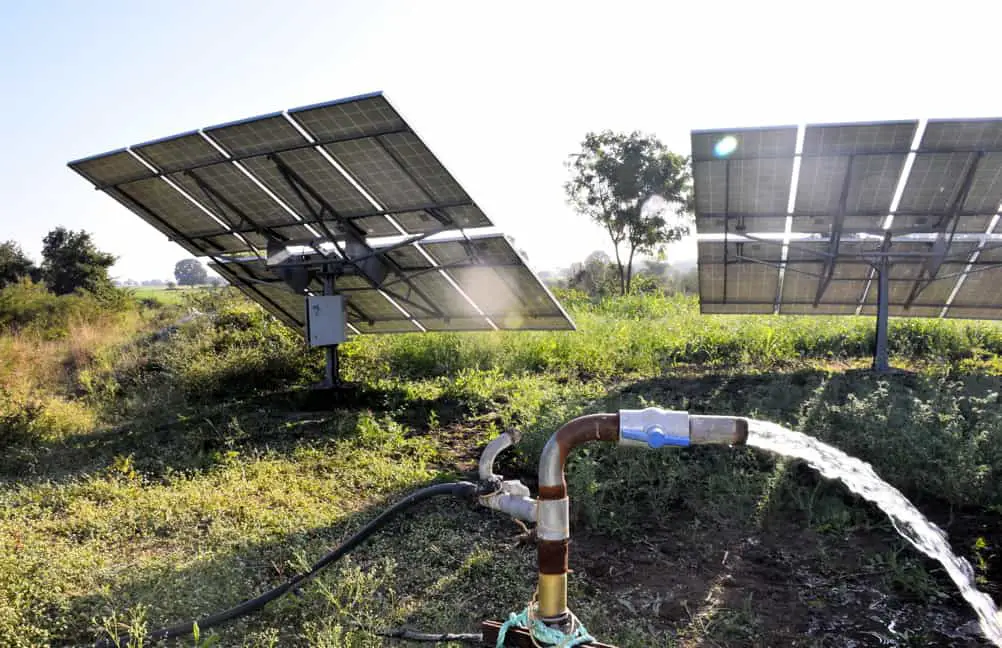
Water is essential for people and the things we grow, but also hard to access and distribute in settings far removed from the utility grid.
Think ranches, farms, cabins, and other off-grid dwellings.
In such remote locations, solar powered water pumps are an increasingly popular alternative to the expense of tapping into the grid.
And with a few simple components, solar pumping can be used in a variety of settings.
Here we discuss the merits of solar pumps, detail how these systems operate, and explore the ideal situations for their application.
We also compare the cost of a solar powered pump versus grid hookup and look at some insightful case studies.
Table of Contents
- Benefits of Solar Powered Pumps
- The Nuts and Bolts of Solar Powered Pumps
- The Water Pump
- Energy Demand of Solar Pumps
- How Deep Can a Solar Pump Work?
- The Cost of Using the Electrical Grid
- The Costs of Solar Pump Technology: How Much Water per Buck?
- Solar Well Pump Kits
- Are Solar Pumps Competitive Over the Long Term?
- Real-World Use of Solar Water Pumps
- Submersible Solar Water Pumps: the Hidden Cost of Solar?
- Conclusion: Benefits and Trade-offs of Solar Water Pumps
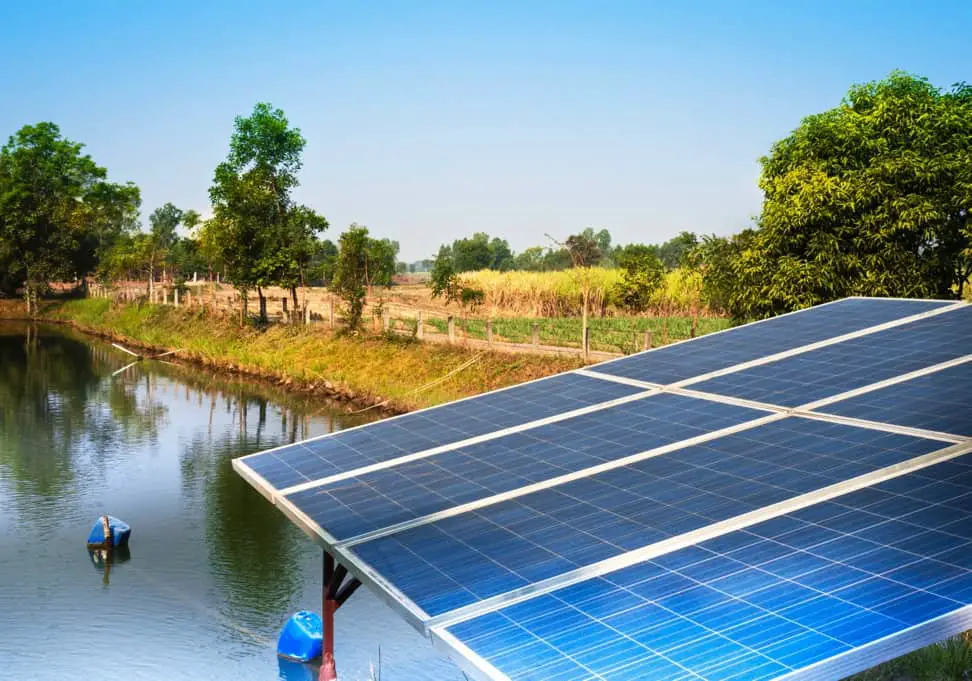
Benefits of Solar Powered Pumps
What tips the scale towards solar pumps?
In our research of the solar pump market, we have discovered that there are several features inherent to solar water pumps that can make them advantageous:
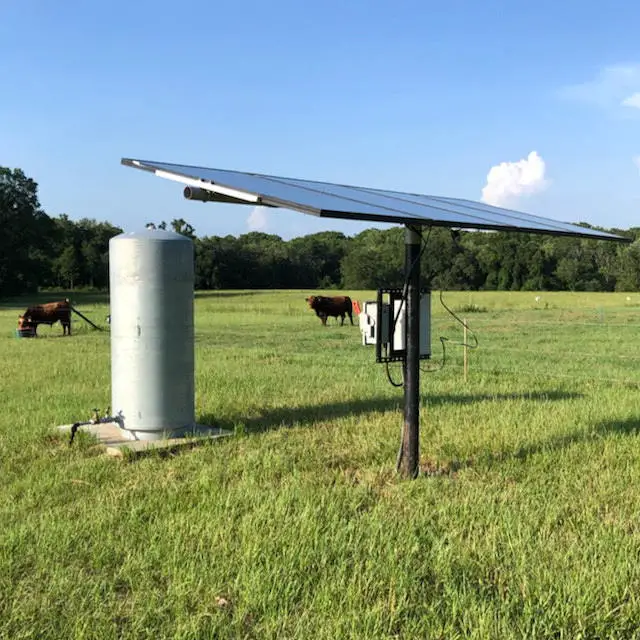
The Nuts and Bolts of Solar Powered Pumps
There are two main components to a solar powered pump: solar panel arrays for collecting the sun’s energy, and the mechanical pump for moving water.
To make the most of solar’s potential, it’s essential to understand how solar water-pumping systems function. Let’s start with the sun.
Solar Energy Basics
Every solar setup starts with photovoltaic cells. The cells are what produce electricity from solar radiation. Many photovoltaic cells are linked to make a solar panel, and several panels operating together make a solar array.
Solar panels generate direct current (D/C) instead of the alternating current (A/C) used in households. The amount of power produced by a system is dependent on the type of cells, the panel size, and the number of panels in an array.
The power from solar panels is rated in watts. A watt is a unit to describe energy output or demand for electrical fixtures. You might be familiar with this concept for everyday household gadgets such as a 60-watt incandescent lightbulb.
For solar systems, watts refer to supply or solar panel capacity. Individual panels come in an assortment of wattages, anywhere from tiny 50-watt to whopping 400-watt panels.
The output of each panel is not as important as the total output of the array. For instance, a 300-watt array can be made using three 100-watt panels, two 150-watt panels, or one 300-watt panel.
In short, solar panels are the power supply for pumping water.
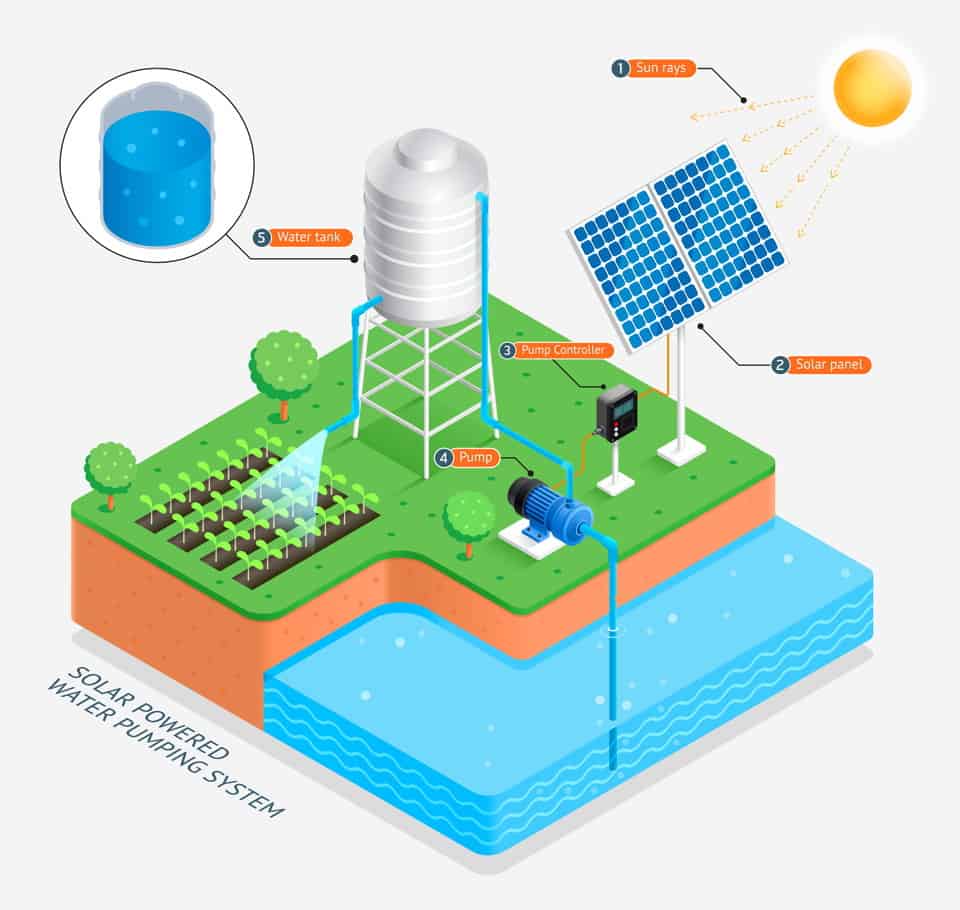
The Water Pump
A pump is any device that uses an energy source to move fluids.
In our case, a pump is a tool that mechanically draws water from a source and delivers it to the desired location. There are many types of pumps for just this purpose, but some pumps work better with solar power.
In particular, pumps that require less power to operate at peak efficiency are ideal. For deep wells, positive-displacement (PD) pumps are sometimes recommended. These pumps, mounted above-ground and move a fixed amount of water with every rotation cycle, pump proportionally to the amount of power supplied.
Compare PD pumps to centrifugal pumps commonly used with A/C power and also installed above-ground. If you have a deep well supplying your house with water and you’re on the utility grid, you might use a centrifugal pump.
Centrifugal pumps draw a lot of power to pump as fast as possible. However, at lower power, they underperform. For instance, a centrifugal pump will only pump at a quarter of its maximum pressure when running at half power.
Submersible D/C water pumps, which operate at the bottom of the well, use only 20 to 50% of the energy required by A/C centrifugal pumps to move the same amount of water. This difference in energy demand is why solar energy works so well with D/C pumps.
Energy Demand of Solar Pumps
Several factors determine the energy demands of solar water pumps.
The head, or the vertical distance that the water must be pulled or pushed from the source, largely determines power need. For instance, the head on a water draw from a surface pond is generally much smaller than the head on a deep well.
Additional considerations are the horizontal distance water must travel from the pump to the application and the dimensions of water supply lines.
Another obvious factor is the water demand itself which is often reported in gallons per day.
An important thing to note here is that higher energy demands translate to more solar panels. More panels mean more cost and more infrastructure.
The Solar Pump Advantage
But don’t despair over your investment in solar-powered pumps!
While it is true that pumps rated for solar use may take longer each day to satisfy water demand, they will pump just as much water over an entire day of solar exposure as standard A/C pumps but at a portion of the cost.
The reason for the solar advantage is that A/C pumps, in comparison, draw a lot of power to pump quickly and then shut off. But solar pumps work at the same rate that solar energy is being converted.
In other words, water is pumped as long as the sun shines, and the good news is the cost of a solar pump balances out by the end of the day.
A setup like this doesn’t require a battery bank for storing electricity, and when sunshine is abundant, a solar pumping system can fill an auxiliary tank for cloudy days.
How Deep Can a Solar Pump Work?
Solar pumping systems can be scaled to fulfill most water needs but can be limited by the depth of the water source.
As discussed, the energy and cost advantage of pumps for solar applications is due to lower power demand. Although lower power translates to lower overall output, most pumps can lift water vertically between 75 and 350 feet.
Some solar pumps are rated for greater depth, but the increased cost of these products quickly offsets the benefit of solar pumping.
The Cost of Using the Electrical Grid
The cost of stretching power lines can be substantial for sites that are not connected to the grid.
According to an article by the University of Iowa, in many rural parts of the US, the average rate for adding power lines beyond 1000 feet from the nearest grid-tie is $5 per foot, which totals greater than $25,000 per mile.
And it can get worse than that.
You may incur more costs if there’s dense vegetation, unfavorable soil conditions, or elevation changes.
Unless participation in a rural power co-op is an option, the landowner will eat these costs directly. Running utilities to sites more than one-quarter mile from the connection is quite expensive.
And though rates for electricity differ by utility provider and region, there is nevertheless a recurring payment for usage after installation.
Add it all up, and the costs of tapping into a utility grid make solar pumps are much more attractive option.
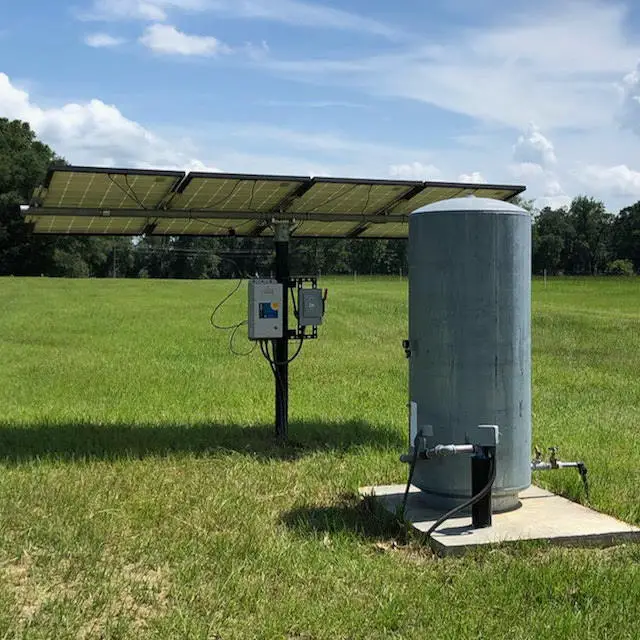
The Costs of Solar Pump Technology: How Much Water per Buck?
In my market research, I found that a solar water pump kit for irrigation ranges from $2000 to $5000 for a solar array and pump, along with all connections.
The kit includes a pump for $1200 to $2500 with a balance of no more than $2 per watt for the solar panels.
The total cost for a pump kit largely depends on water demand in terms of flow rate, daily volume, and shipping to the buyer.
Costs also depend on the water source. Surface water systems, such as those that draw from a pond or river, will tend to be cheaper due to less energy demand than water pumps submerged deep into a well.
I also found that seasonal discounts are often quite deep, with up to 25% off the retail price. Keep your eyes open for sales and use price trackers for instant alerts.
Solar Well Pump Kits
Below are some examples to illustrate how water output from a well relates to cost. The figures given here from RPS Solar Pumps are merely for demonstration purposes and not intended as an endorsement.
According to RPS, three of their solar well pump kits serve about 90% of their client’s pumping needs. In my assessment, these products represent typical costs, components, and output available on the market.
Each model of solar water pump kit is driven by a submersible brushless motor which eliminates the need to replace worn-out brushes. Also included are a pump controller, various connectors and fittings, shut-off sensors for tanks and wells, and a two-year comprehensive warranty.
| Pump Model | RPS 200 | RPS 400 | RPS 800 |
| Number of Solar Panels | 2 x 100-Watts | 4 x 100-Watts | 8 x 100-Watts |
| Maximum Output GPM, GPD (no head) | 5.1, 1836 | 7.6, 2736 | 8.9, 3204 |
| Output at Max Depth GPM, GPD (max head in feet) | 1.5, 540 at 150′ | 1.2, 432 at 250′ | 4.1, 1,400 at 325′ |
| Total Kit Cost | $2,150 | $2,550 | $3,500 |
Of course, other options are available such as solar-powered dewatering pumps, which can grind up and pass debris drawn up from a pond, creek, or ditch.
Keep in mind, however, that the more specialized the application, the more costly the components. If your needs are on the less complex end of the scale, then you can quickly realize the cost benefits of solar water pumps.
And don’t forget to factor in the costs of water tanks, water lines, and the parts for connecting to the solar-powered pump. These pieces are seldom included in the kit price.
Are Solar Pumps Competitive Over the Long Term?
In the scenarios given above, installing solar pumps can be much cheaper than extending power lines. There are many conditions where this holds true.
In the case where electric company infrastructure must be extended more than one-quarter of a mile, solar pumps have a clear cost advantage.
However, one must also consider the longevity of such projects.
A downside with many solar pump setups is that they need servicing and components periodically replaced. For instance, smaller well pumps may have to be serviced every two to four years, while larger well pumps and surface pumps require service every 15 years.
In addition, most solar panels these days have life spans between 20 and 30 years.
Ensuring things are adequately installed and maintained for the intended use will offset some of these issues. However, the replacement of solar cells and pump components is inevitable.
Real-World Use of Solar Water Pumps
Now that we understand the basics of solar water pumps, we will look at a couple of applications that demonstrate the potential as well as the constraints of using solar systems.
Case 1: Solar Pumps in Senegal
In rural Senegal, where I worked as a Peace Corps Volunteer, water is the most limiting factor for vegetable productivity. Water use is also the largest consumer of time and labor where gardeners water with a pail or bucket.
In this setting, tapping into the electrical grid is usually not an option, and once gardens are above a particular scale, hand-drawing water is not an option either.
When international aid organizations partner with these communities to build sustainable food practices, it is solar pumping systems that local farmers want.
A standard setup for a Senegalese community garden is to have a centralized well that feeds cisterns located throughout. Solar pumps draw water from a shallow, sand point well, and fill an elevated reservoir. This reservoir then gravity feeds water to cisterns built at waist height. From here, gardeners fill buckets at cisterns closest to their vegetable plot.

Solar Water Pump For Irrigation
On many private farms in Senegal, solar-powered pumps are an integral part of drip irrigation systems.
In drip systems, solar pumps transfer water from shallow wells and up into elevated water tanks. Gravity-fed irrigation lines that feed off the tanks then rely on the height of the water to provide adequate pressure for water flow.
Determining the height needed to achieve a certain water pressure is straightforward.
The rule of thumb is that you need 2.31 feet of vertical elevation at the water tank outlet for each pound per square inch (psi) of water pressure needed to push water through drip emitters.
Most towers are from 15 to 30 feet above the ground, and from there water is gravity fed back down through irrigation piping. Most often, such elevations are adequate for drip lines that require between 10 and 15 psi pressure.
There is no shortage of sunlight during the vegetable-growing season in Senegal, and there is enough solar energy to supply all the water demand. And with an efficient flow rate, there is less risk of drying up the well through over-pumping and drawdown.
The application of solar pump technology in Senegal has proven to significantly impact the productivity of farms and gardens.
Case 2: Off-Grid Solar Powered Water Pumps for Cattle Ranches
Refilling livestock water reservoirs is perhaps one of the most appropriate uses for solar water pumping.
Ranches with large tracts of land, far away from municipal utilities, and plenty of thirsty animals are great candidates for solar-powered technology.
In Cherokee County, Iowa, cattle rancher Dick Lester found solar was the best solution for his watering needs on a 650-acre pasture.
Before installing a solar pump system, the only available water source on Lester’s property was a small creek that ran through the pasture.
With over 300 head of cattle, this riparian system was constantly being gouged away by herd traffic, and the creek’s banks were left bare of grasses and susceptible to erosion.
Lester deduced that giving his herd multiple water sources would break up the group and would result in more even grazing. Therefore, the need to pump water was apparent, and the decision to go solar was a no-brainer in Lester’s case.
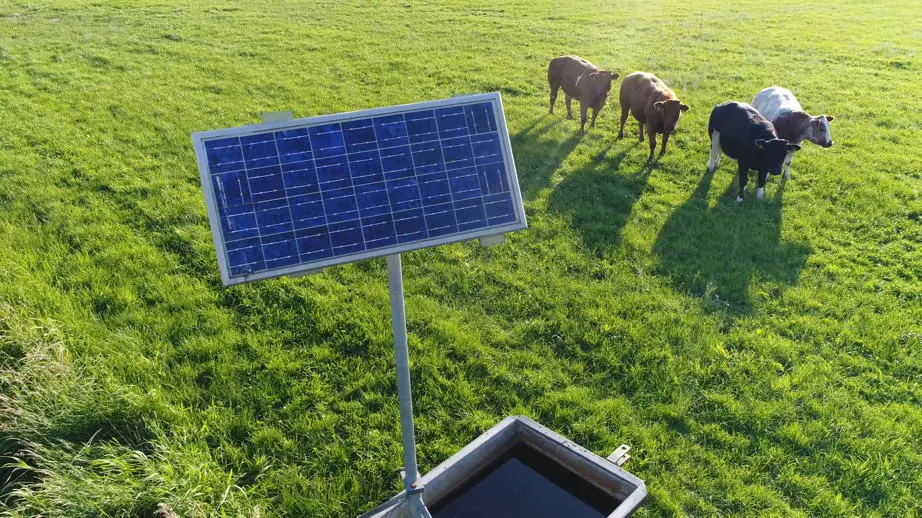
When pricing his pumping needs, Lester got $4.75 per foot, totaling $20,000, to run electricity out to his water pump. On top of that, he would pay $30 a month in fees, not including the cost to power the pump.
The company that installed the solar pump system estimates that a complete setup for ranchers is usually between $5,000 and $7,000, including installation.
Factor in sizable cost-share initiatives offered by the Natural Resources Conservation Service for solar pump installation, and there is nothing that comes close to being as effective and affordable.
After considering the alternatives, Lester installed an array of eight 175-watt solar panels. These panels power a pump that draws water from the creek and then delivers it through 4,600 feet of pipe to fill each of three large tanks. Fill valves switch the pump on and off based on the water level in the stock tanks.
Lester’s installation is an excellent example of how you can use solar power to supply water on demand. Also, by storing plenty of water in the tanks, there is no need to have batteries for times when there is a lack of solar power.
Systems like this have picked up traction at ranches across the US. And with cost-share programs like those offered by the NRCS and other rural resource organizations, this is the best deal for livestock watering.
Submersible Solar Water Pumps: the Hidden Cost of Solar?
As previously mentioned, solar pumps come in two main categories: surface and submersible.
Surface pumps are straightforward in application. In any body of water, these pumps can deliver flow rates between four and ten gallons per minute, on average, without drawing much power.
In addition to pumping from natural water bodies, this is a good option for cisterns and other water catchments.
For drilled wells, you’ll have to install a submersible pump.
Submersible pumps designed for solar power are more energetically conservative so that the supply from the panels can maintain the pumping demand.
The questions are, how deep into the earth do you need to go and how much water do you need? The deeper it goes, the more it costs, a fact that holds true for all drilled wells and not only solar pump wells.
As previously noted, however, there is a limit to the vertical height solar pumps can move water. The maximum vertical lift for most pumps is between 75 and 350 feet, and though some can go deeper, the increased requirement on design brings the pump prices up and cost savings down.
In most applications, it will not be necessary to sink wells any deeper than the upper edge of the water table. Water safety considerations aren’t essential for plants and livestock, so shallow wells are usually sufficient. The lower flow rate of these pumps complements shallow and slow-restore wells.
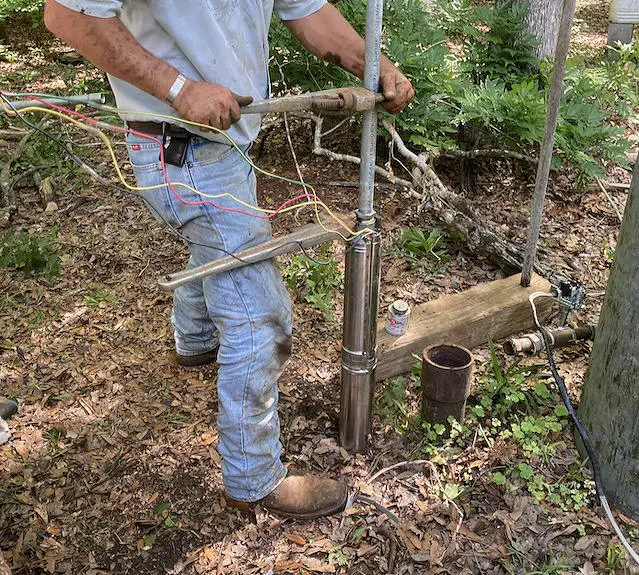
Conclusion: Benefits and Trade-offs of Solar Water Pumps
Solar water pumps are higher efficiency solutions for many off-grid watering applications.
The technology is suited for a range of water needs but is optimized for systems with low flow.
Solar pumps are also well suited for areas where other power sources are unavailable or too costly to access. The most relevant applications include crop irrigation, refilling livestock water basins, and regulating water levels in ponds and lakes.
Solar-powered pumps are useful for supplying gravity-fed systems and distributing stored water. Pumps can be used in surface water or groundwater sources.
Many retailers offer self-contained solar well pump kits that include solar panels and all the other components needed to make installation a straightforward process.
The most significant trade-offs are in power and unit lifespan.
Solar pumps sacrifice maximum lift power for pumping efficiency, and there are limits to the rate at which you can convert solar energy to electricity even under peak solar intensity.
For very deep water or high flow rate requirements, solar water pumps aren’t economically competitive. Even if functional, using the systems closer to their upward limit increases wear and tear on pump components, which only hastens the need to service or replace the system.
As insurance against inadequate solar power, you can wire backup systems into the breaker box for a gas-powered generator and the utility grid as a power source.
Regardless of the power load, the solar array and pump will need regular attention and periodic upgrading of system components.
Although the longevity of such systems may be limited, there are plenty of practical, cost-effective applications to justify the investment.
As interest in solar pumping systems increases, improvements in existing designs will advance this technology even further.
Inside the lab and out, at home and abroad, Ethan is a student of sustainable farming. With a B.S. in environmental agriculture from the University of Florida, he has had his hands in farming at multiple climes, including Senegal with the Peace Corps.
The solar system very nice idea .Today so many farmers facing the problem of electricity everywhere. Pls reduce the cost of such solar system
Dr S M Pawar
Thanks
Ethan, loved the article.
I have some farm ground In Newnan Georgia that used to be part of a large cotton Field, thousands of acres in fact.
I’m in the process of digging a well. I’m finding water 30-35 gpm @ 450 feet, but I’m hoping to find considerably more using hydrofracking.
However, assuming 30-35 gpm is the max and at 450 feet, I’d like to still explore solar pumps to extract the water.
What Is available to me in this project in the way of working with local universities, govt loans/grants/tax relief Etc.
I know But the technology in this field is changing rapidly in the efficiency of these homes is improving to the point that 450 to 500 feet may be cost-effective.
Anyway, I will soon know what the output is on this well, and we can then go from there.
Nick Vlachos, MD
Lagrange, GA
Hello Dr. Vlachos,
Thank you for writing and your interest in the subject.
As you suspect, there are solar pumping systems that can be effective below 450 feet. The efficiency of these systems depends on your intended usage. Likewise, different types of assistance (e.g., cost sharing) will be available depending on what you are using the water for and other aspects of the well, landscape, land status, etc. Developing high-output systems at greater depths is at the forefront of this technology, but some options do exist.
If you would like to discuss this further, please feel free to reach out.
Cheers,
Ethan
Very interesting I’m a farmer I wish to install a solar water pump in my farm.
How go about it?
There was one thing that I did not see in this article, the basic soyiredlar systems for AC powered pumps needs solar panels, with their output managed by a solar controller charging batteries, where a inverter is attached to generate AC to power the AC poweredm pump. ..
The latest style is DC powered pumps, connecting directly to the solar panels, I have one ordered that runs on 96 vdc..lifts 70 meters. All is good
I need to purchased a solar powered irrigation system for my farm on the Senegal river.
Land area to be irrigated is around 100 acres.
Any recommendations?
Great article with lots of information. We currently have a fuel driven generator (8200 watts) that we run once a week for 5hrs to fill two 2500 tanks for personal use up 300ft in a 1/2 inch pipe on a mountain. The well is almost 800 ft. With gas prices going up with no stop in mind and if SHTF, there will be no gas. Is the depth too great to have a solar well pump..??